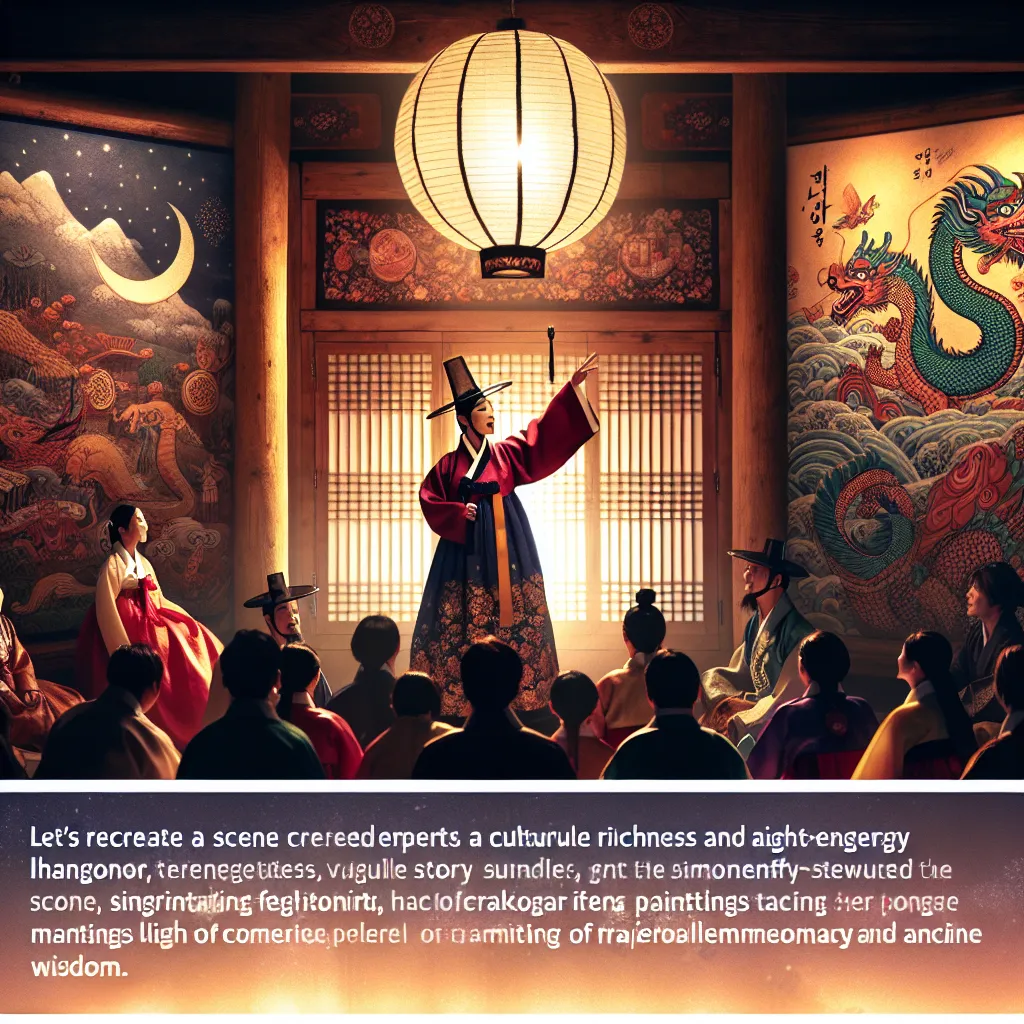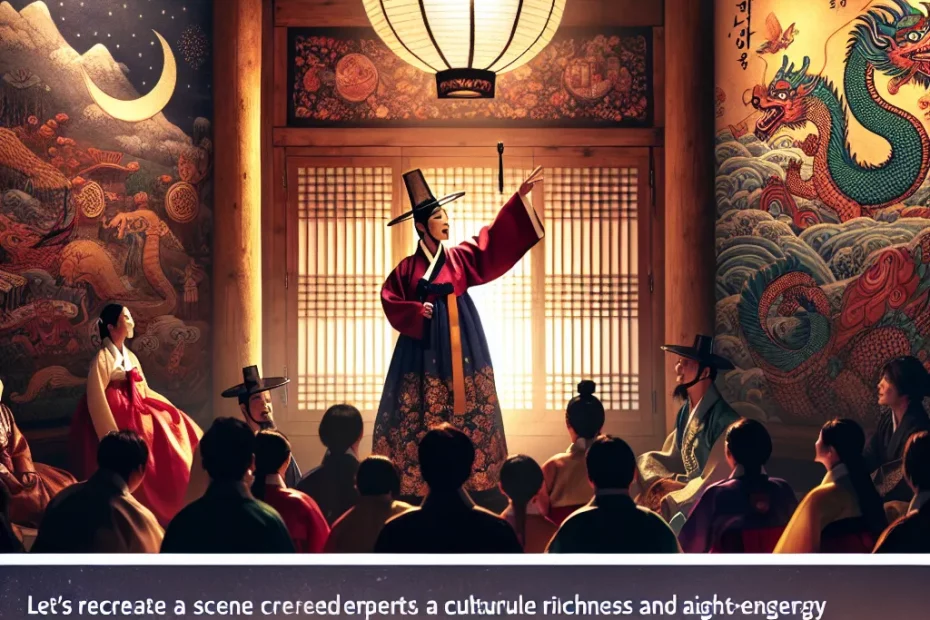Korean folklore is a treasure trove of wisdom and tradition that has been passed down through generations, shaping the cultural identity of the Korean people. These stories, filled with symbolism and deep meanings, offer insights into the values and beliefs of the society. From tales of mythical creatures to moral lessons, Korean folklore reflects the rich tapestry of customs and beliefs that have endured over time. Today, these age-old stories continue to inspire modern culture, bridging the gap between the past and the present. As we delve into the world of Korean folklore, we uncover a legacy of storytelling that not only entertains but also educates, providing a glimpse into the soul of a nation shaped by its myths and legends.

The Stories Passed Down Through Generations
In the rich tapestry of Korean culture, folklore plays a vital role in preserving the wisdom and traditions of the past. These stories, passed down through generations, carry with them the essence of Korean identity and values. From tales of mythical creatures to stories of love and sacrifice, Korean folklore reflects the beliefs and experiences of the people throughout history.
One of the most well-known Korean folktales: “The Sun and the Moon”
🌟 One of the most well-known Korean folktales is “The Sun and the Moon.” This story illustrates the eternal cycle of light and darkness, symbolizing the balance and harmony in the universe. Through the characters of the Sun and the Moon, the tale imparts lessons of cooperation, interdependence, and the interconnectedness of all things.
Another beloved folktale: “The Woodcutter and the Fairy”
📜 Another beloved folktale is “The Woodcutter and the Fairy.” This story highlights the importance of kindness, humility, and the rewards of selflessness. It teaches us that good deeds are always repaid, sometimes in the most unexpected ways.
Korean folklore and nature spirits
🌿 Korean folklore is also rich in stories of nature spirits and guardian deities. These tales reflect the deep reverence and respect that Koreans have for the natural world. From the mystical Dokkaebi to the noble Jacheongbi, these mythical beings embody the symbiotic relationship between humans and nature.
Traditional Korean masks and their significance
🎭 Traditional Korean masks, used in various folk performances, are not just decorative but hold symbolic meanings rooted in folklore. Each mask represents a specific character from Korean myths and legends, showcasing the cultural significance of storytelling in Korean society.
The enduring popularity of Korean folklore
🌌 The enduring popularity of Korean folklore is evident in its influence on modern media, such as K-dramas, movies, and literature. These contemporary adaptations keep the spirit of traditional stories alive, ensuring that the wisdom and values embedded in Korean folklore continue to resonate with audiences worldwide.
Through the timeless tales of Korean folklore, we gain insights into the collective consciousness of a nation, the values that shape its people, and the enduring power of storytelling to connect generations. Let us continue to treasure and pass down these stories, for they are not just tales of the past, but living legacies that enrich our present and inspire our future. 🌟
Symbolism and Meanings in Korean Folklore
In Korean folklore, every story, every character, and every symbol holds a deep and profound meaning that reflects the wisdom and traditions of the Korean people. These tales have been passed down through generations, serving as a cultural compass that guides individuals on their journey through life. Let’s delve into the rich tapestry of symbolism and meanings found in Korean folklore.
🌟 The Tiger
One of the most iconic symbols in Korean folklore is the tiger. Tigers are often portrayed as powerful and majestic creatures, symbolizing courage, strength, and protection. In many folk tales, tigers are depicted as both fearsome adversaries and benevolent guardians, showcasing the duality of their nature.
🌙 Moon Imagery
Moon imagery is another prevalent symbol in Korean folklore, representing femininity, beauty, and enlightenment. The moon is often associated with goddesses and deities in Korean mythology, signifying the cyclical nature of life and the passage of time.
🌸 Flowers
Flowers, particularly the lotus flower, hold significant symbolism in Korean folklore. The lotus flower is a symbol of purity, enlightenment, and rebirth. Its ability to rise from muddy waters and bloom into a beautiful flower mirrors the journey of the soul towards enlightenment.
🔥 Fire
Fire is a powerful symbol in Korean folklore, representing both destruction and renewal. Fire is often used in tales to symbolize transformation, purification, and the cyclical nature of life and death. It serves as a reminder that from destruction comes new beginnings.
🌿 Trees
Trees, especially the pine tree, are revered in Korean folklore for their longevity, resilience, and wisdom. Pine trees are often depicted as symbols of endurance, steadfastness, and immortality, serving as a source of inspiration for those facing challenges in life.
🎭 Masks
Masks play a significant role in Korean folklore, representing the complexities of human emotions and identities. Masks are used in traditional Korean performances to portray various characters, each with its own unique personality and story, highlighting the multifaceted nature of human existence.
Through these symbols and their meanings, Korean folklore not only entertains and educates but also provides valuable insights into the cultural values and beliefs of the Korean people. Each symbol serves as a thread in the rich tapestry of Korean folklore, weaving together stories of wisdom, tradition, and the eternal quest for understanding the mysteries of life.
Let us continue to unravel the intricate web of symbolism and meanings in Korean folklore, honoring the legacy of our ancestors and embracing the timeless wisdom they have passed down to us through these captivating tales. 🌟📖
Traditional Customs and Beliefs
Ancestral Worship: Jesa
Ancestral worship, known as Jesa, is a cornerstone of Korean tradition. Families gather to pay respects to their ancestors, offering food and drink as a sign of gratitude and reverence. This practice not only honors the past but also strengthens the bonds between family members, fostering a sense of unity and continuity across generations.
Shamanism
Shamanism, another integral part of Korean folklore, involves rituals and ceremonies conducted by shamans to communicate with the spirit world. Shamans act as intermediaries between the living and the dead, seeking guidance and healing for those in need. The rituals are often accompanied by music, dance, and chanting, creating a mystical atmosphere that transcends the boundaries of the physical realm.
The Concept of Yin and Yang
The concept of yin and yang, representing the balance of opposing forces in the universe, is deeply ingrained in Korean beliefs. This dualistic philosophy influences various aspects of Korean culture, from traditional medicine to architecture. The harmony between yin and yang is believed to bring about health, prosperity, and good fortune.
Folk Tales and Legends
Folk tales and legends, such as the famous story of “Heungbu and Nolbu,” are cherished for their moral lessons and cultural significance. These tales often feature themes of filial piety, loyalty, and justice, serving as a guide for ethical behavior and social harmony. Through storytelling, Koreans pass down valuable lessons from one generation to the next, preserving their cultural heritage.
In conclusion, traditional customs and beliefs form the foundation of Korean folklore, embodying the wisdom and values of the Korean people. By honoring the past and embracing the spiritual world, Koreans continue to uphold their rich cultural heritage and traditions, ensuring that their legacy endures for generations to come. 🌺📜
Korean Folklore in Modern Culture
In the vibrant tapestry of Korean culture, folklore stands as a timeless thread weaving through the past, present, and future. These tales of wisdom and tradition have not only shaped the collective consciousness of the Korean people but continue to influence modern society in profound ways. From ancient myths and legends to moral fables and ghost stories, Korean folklore reflects the values, beliefs, and customs of the Korean people, offering a window into the rich tapestry of the nation’s heritage.
The Legacy of Korean Folklore
Korean folklore is deeply rooted in the country’s history, with stories passed down through generations orally and in written form. These tales often carry moral lessons, serving as a guide for ethical behavior and societal norms. Characters like the cunning fox spirit, the loyal goblin, and the wise old man embody virtues such as loyalty, filial piety, and perseverance, resonating with audiences of all ages.
Traditional Tales in a Modern World
Despite the fast-paced nature of modern society, Korean folklore continues to hold a special place in the hearts of the Korean people. In recent years, there has been a resurgence of interest in traditional stories, with adaptations in various forms of media such as films, TV dramas, and literature. These modern retellings breathe new life into age-old tales, making them accessible to a wider audience while preserving their cultural significance.
Folklore in Popular Culture
Korean folklore has also made its mark on the global stage, with elements of traditional stories finding their way into popular culture. From the iconic figure of the nine-tailed fox in K-dramas to the mystical creatures in K-pop music videos, Korean folklore continues to captivate audiences around the world. The enduring popularity of these themes speaks to the universal appeal of folklore in conveying timeless truths and universal values.
Preserving Heritage Through Folklore
In an era of rapid globalization and cultural homogenization, Korean folklore serves as a powerful tool for preserving and celebrating the unique heritage of the Korean people. By retelling traditional stories in innovative ways and incorporating folklore into contemporary art forms, Koreans are able to bridge the gap between past and present, ensuring that the legacy of their ancestors continues to thrive in the modern world.
In conclusion, Korean folklore remains a vibrant and integral part of modern culture, offering a glimpse into the soul of a nation rich in tradition and wisdom. As these timeless tales continue to resonate with audiences both in Korea and beyond, they serve as a reminder of the enduring power of storytelling to connect us to our past, inspire us in the present, and guide us into the future.
Korean folklore holds a rich cultural significance, embodying tales of wisdom and tradition that have been passed down through generations. These stories not only entertain but also serve as valuable lessons, teaching morals and values to listeners. The symbolism and meanings found in Korean folklore reflect the deep-rooted beliefs and customs of the Korean people, offering insights into their way of life. From mythical creatures to legendary heroes, each story carries a unique message that resonates with audiences. Even in modern culture, Korean folklore continues to inspire art, literature, and entertainment, keeping the spirit of tradition alive. The enduring legacy of Korean folklore reminds us of the importance of preserving our cultural heritage for future generations to appreciate and learn from.
